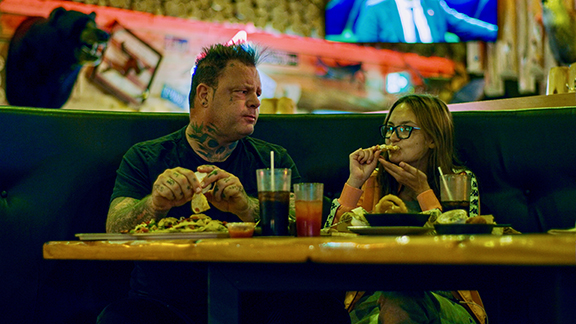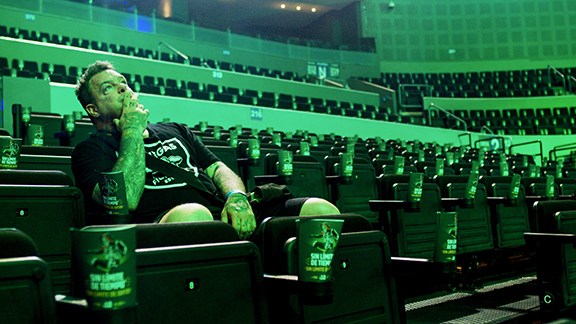Review: Nail In The Coffin: The Fall & Rise Of Vampiro
Let’s play ‘judge the movie by the title’ where your given motion picture today is entitled Nail in the Coffin: The Fall & Rise of Vampiro.
Wrestling fans would be forgiven for thinking that this feature length documentary following the life and career of the titular wrestling star, is a straight-up behind the scenes pro-wrestling movie, or even a simple biography piece on a man who made his name in the world of Lucha Libre.
For those that don’t know the name Vampiro, the B-movie undertones of the title alone might even trick some casual viewers into thinking it’s a schlock horror video nasty. After all, there are moments in the film that feature so much blood that you could easily think we’re in Hammer Horror territory – blood that, depending on the scene, is either fake or very real.
Ironically, whichever of the above assumptions you jump to would be, to some degree at least, pretty damn accurate. Using a mix of archive footage and content shot especially for the documentary, we do indeed get an unprecedented look inside the life of Ian Richard Hodgkinson – the man behind the white face paint of Vampiro.
Due to the nature of his career, of course there’s a major focus on the world of pro-wrestling in general and of Lucha Libre in particular. It’s also true that the pain Hodgkinson the man has to live with as a legacy of being Vampiro the wrestler is certainly horrific to see. There are genuinely heart-breaking scenes contained within the 88 minutes we spend with him. You’ll want to reach through the screen and help him navigate his way down a barely 3-inch curbstone at one point, such is the seemingly insurmountable problem that stepping down from it is causing him.
Dig a little deeper and you realise that at the real heart of this feature, it’s a much simpler and more personal story than the title suggests. In fact, we’re not dealing with an exploitative horror movie, or a documentary where wrestling takes centre stage at the expense of everything else.
This is a love story.

It’s about the love a father has for his daughter. It’s about the love she feels for him. It’s about how that love develops and changes over time, from something hard-coded, instant and familiar to something unrecognisable but still very much true.
It’s also about how this parental love for a child can bleed into an existing love of wrestling, and drive a performer like Vampiro to keep going, keep working, keep earning and keep on providing for those that he loves – even when it’s against the explicit advice of medical professionals, his own common sense and ultimately, the body’s physical ability to do so. Indeed, quite how a boy called Ian, born in Thunder Bay Ontario, Canada manages to go on to be one of the biggest stars in Mexican wrestling is quite the story – one with more than a few unexpected turns along the way.
Oh yeah, it’s also a little bit about disgraced 90s pop group Milli Vanilli, but we’ll get back to that later.
“Have you ever heard of the Sex Pistols?”
Vampiro
In Director Michael Paszt’s film, we’re introduced to Vampiro as a man who is clearly still passionate about the wrestling business. Now semi-retired from performing in the ring, we witness him screaming at monitors backstage as he communicates with and barks orders at referees, with in-ring talent, with camera crews… and just a little bit with himself. We see him go from a backstage production role at Lucha Libre AAA in Mexico to becoming an in-ring talent within moments, pausing only to take off the radio mic he’s wearing for the documentary because he doesn’t want it to get broken in the ring.
We see him deal with conflicts behind the scenes, negotiating his way through a tense real-world stand-off between Jeff Jarrett and Kevin (now Karrion) Kross, where the former is hurling expletives and swinging wildly at luchadors and the latter stands with a chair in hand, ready to start swinging back. Vampiro admits: “The whole dressing room was ready to go. It got intense back there.” To say Jarrett comes off looking bad would be the understatement of the year. Indeed, the first major show that the documentary chronicles, the AAA Triplemania XXV 25th anniversary event, was steeped in controversy: it was claimed that Jarrett was unfit to wrestle, while on the luchadora side in the Reina de Reinas (Queen of Queens) Championship match, Sexy Star would apparently legitimately injure Canadian pro-wrestler Rosemary after losing her temper in the ring. Probably not the sort of show where you’d find Vampiro remaining that calm and composed, all things considered.
Jumping back, we learn about Hodgkinson’s early life, his childhood, and the challenges he faced in his youth. Experiences of shocking sexual assault as a boy do get acknowledged, but are given little airtime, almost to suggest he’s in a place where he can go “Yes, it happened. Yes, it was a massive abuse of trust but no, screw the Catholic church, it won’t define me.” We learn of his health battles – he’s been treated for a broken back, a brain tumour and stomach cancer, as well as for a litany of concussions that comfortably reach double figures.
We watch how he was influenced by the look, feel and music of the Sex Pistols (and specifically by bassist Sid Vicious), dying and spiking his hair to match the iconic punk figure. Never mind the bollocks, indeed: here lies the origin of Vampiro.
We hear him recount how, flicking through TV one Saturday evening, he catches an AWA match where the Road Warriors demolish their opposing team in less than two minutes, all facepaint, muscles and tattoos. The young Hodgkinson is left thinking in that moment how punk and wrestling had mixed before his eyes to create a hedonistic, intoxicating chemical compound that spoke to the young Vampiro like little else had before.
We discover that real-world illicit chemicals would go on to play a part in his formative years too. Indeed, via a chance meeting at a gym with a new acquaintance that had links to organised crime, Hodgkinson would go on to gain the approval of a Canadian mafia family, tag along on mob jobs, shake down pimps for money and do things that placed the would-be Vampiro undeniably on the wrong side of the law.
In an attempt to get away from that lifestyle, Hodgkinson wound up in LA at 18 (“Everybody looked like a vampire,” he explains), ultimately working for different music artists. Most notably, he played bass for Rob Pilatus and Fab Morvan – better known as late 80s pop duo Milli Vanilli – which led to Hodgkinson going on tour with the band, witnessing first hand the machine that quietly exists between superstars and the fans that follow them. This in no small part plants the seed that would see him become a backstage talent manager and booker in later years. Ironic, really, that Milli Vanilli were outed as a pair of lip-syncing kids chosen for their look rather than their talent, while the world of wrestling deals with its own accusations of being fake due to the pre-determined nature of the competitions. To thine own self be true… even if showbusiness isn’t all that true to itself.
“The worst drug in professional wrestling is believing your own hype.”
Vampiro
Deciding that Hollywood was too much for him, he headed south, making the first of many trips to Mexico, where Vampiro was truly born. “It was pretty cool,” he admits. Wrestling six or seven times a day, seven days a week was not uncommon. Neither, it seems, was getting shots from veterinarians that promoters brought in to keep their talent working through injuries. In spite of the schedule, Vampiro remained as a cornerstone of many Mexican promotions for over seven years, ignited a long-running feud with Konnan along the way, before ultimately landing in WCW in 1998. Runs with Ric Flair, Hulk Hogan, Jeff Jarrett and Sting followed, while Vampiro’s punk rock persona would also attract bands like the Misfits and Insane Clown Posse to appear by his side on WCW Monday Nitro. Sadly, his run ended with a top rope powerbomb from Mike Awesome… and a broken neck as a result.
Incredibly, this didn’t signal the end of his wrestling career. After the purchase of WCW, Vampiro would go on to compete around the world. Runs in Mexico’s Consejo Mundial de Lucha Libre, Puerto Rico’s World Wrestling Council and All Japan Pro Wrestling followed, as well as a short run in TNA.

Yet it’s his Lucha Libre AAA Worldwide tenure that has been the most enduring and saw Hodgkinson, who at the time lived in his childhood home town of Thunder Bay, north-western Ontario, Canada, make the not inconsiderable journey every week to Mexico City, where he acted as Director of Talent for AAA. It was a big commitment, and one that would put a strain on the most seasoned commuters – Hodgkinson faced at least a 7 hour flight each way, clocking up around 5,000 miles on the round trip: a trip would he complete weekly.
Also in the mix was his run pulling double duty and simultaneously providing colour commentary and acting as occasional in-ring talent for Lucha Underground over in LA. He’s worn many hats in the world of pro wrestling. Yet the message that comes through most clearly in Nail in the Coffin is that his most important role is being a dad – and a single dad, at that.
“I get you out now, maybe you’re not a quadriplegic. I get you out now, maybe your daughter has a dad to walk her down the aisle.”
Dr David Probizanski
“I will put my daughter before God. I will put my daughter before anybody,” Hodgkinson states. I believe him. We see him wince and appear more hurt by the failure of a Facetime call to his daughter Dasha than when taking a fluorescent lighting tube shot to the head. He won’t brag about championships won or pay per view wins secured, but he’ll unapoletically admit to struggling with how his daughter is growing into her independence – or perhaps more accurately, her autonomy from him.
It’s screamingly apparent that everything he does is for, because of or inspired by his daughter. Who knew that Vampiro, above all else, would be a father first? Rather than struggling with his on-the-road absence, he sees it as an opportunity to help his daughter to prepare for independent living. Sure, he’ll send her money, but she has to budget it each week. Yes, he’ll fly to from Canada to Mexico, back to Canada, down to the US and back to Canada every two weeks. But he always comes back for time with his daughter. “I wanna go home. I wanna have an ice cream. And I wanna play Playstation with my daughter.” After spending time getting to know him through this documentary, I want that for him too. I want it for both of them.
And there, seemingly, ends the story. Yet as the credits start to roll, there’s still one more surprise in store from this unlikely hero’s journey. Hodgkinson has clearly fought hard to get to where he has in his career, and he has more than paid his dues to where he should now be able to simply sit back in his black leather chair, grab a drink from his mortuary slab counter, and reap the rewards of those battles. However, tragically, there’s a cruel and awfully unexpected sucker punch at the very end of the film – one that resulted in me audibly swearing at the screen – that reveals that he has at least one more big fight ahead of him. Sure, everyone has to eventually get that last nail in their coffin – but today is not Vampiro’s day. Who knows? Maybe a little punk rock attitude is all it will take to win this next battle too…
